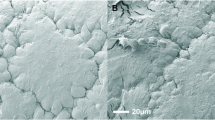Abstract
Lens tissue from a Morgagni cataract was examined by SEM and TEM. For SEM, after prefixation with glutaraldehyde and postfixation with the tannic acid/arginine/OsO4 non-coating (TAO) technique, and for TEM, after prefixation with glutaraldehyde, postfixation with OsO4/K4Fe(CN)6 and poststaining with uranyl acetate/lead citrate. The TAO technique seems to be a particularly suitable postfixation method for the SEM investigation of cararact tissue because of the presence of the protein structures present. The cortical region showed areas of radially, instead of concentrically, arranged lens fibres, degenerated lens fibres with holes (vacuoles), broken ball and socket connections between the lens fibres, and oval or spherical structures varying in size from 0.5–20 μm, the largest resembling a golfball, arising from the cytoplasm of degenerating lens fibres. The smallest, 0.2–0.5 μm, appear to have been expelled from the furrowed lens epithelium.
Similar content being viewed by others
References
Jongebloed WL, Dijk F, Worst JGF. Some aspects of cataract morphology: A SEM study. Doc Ophthalmol 1988; 70: 155–63.
Panessa BJ, Gennaro JF. Use of potassium iodide/leadacetate for examining specimens. In Johari D, ed, IITRI SEM, Vol. 2. Chicago, 1973: 396–402.
Jongebloed WL. Trends in biological scanning electron microscopy. Micron & Microsc Acta 1990; 21: 229–32.
Jongebloed WL, Kalicharan D, Los LI, van der Veen G, Worst JGF. A combined scanning and transmission electronmicroscopic investigation of human (secondary) cataract material. Doc Ophthalmol 1991; 78: 325–34.
Murphy JA. Non-coating techniques to render biological specimens conductive/1980 update. In Johari D, ed, IITRI SEM, Vol. 1. Chicago, 1980: 209–20.
Murphy JA. Non-coating techniques to render biological specimens conductive. In Johari D, ed, IITRI SEM, Vol. 2. Chicago, 1978: 115–93.
Malick LE, Wilson RB. Modified thiocarbohydrazide procedure for scanning electron microscopy: routine use for normal, pathological, or experimental tissues. Stain Technol 1975; 50: 265–69.
Murakami T. A metal impregnation method of biological specimens for scanning electron microscopy. Arch Histol Jap 1973; 356: 323–26.
Murakami T. A revised tannin-osmium method for non-coated scanning electron microscope specimens. Arch Histol Jap 1974; 36: 189–93.
Simionescu, Simionescu. Galloylglucoses of low molecular weight as mordants in EM I & II. J Cell Biol 1976; 70: 608–33.
Karnovsky MJ. Use of ferrocyanide-reduced osmium tetroxide in electron microscopy. Proc 14th Ann Meeting Am Soc Cell Biol 1971; 146.
Reynolds ES. The use of leadcitrate at high pH as an electron opaque stain in electronmicroscopy. J Cell Biol 1963; 17: 208.
Mohanan RH. Channels in the human lens capsule and their relationship to senile cataract. Am J Ophthalmol 1990; 78: 24–29.
Kuszak JR, Ennesser CA, Umlas J, Macsai-Kaplan MS, Weinstein RS. The ultrastructure of fiber cells in primate lenses: A model for studying membrane senescence. 1988; 100: 60–74.
Author information
Authors and Affiliations
Rights and permissions
About this article
Cite this article
Jongebloed, W.L., Kalicharan, D., Los, L.I. et al. Study of the substructure of the Morgagni and Brunescens cataract with the TAO non-coating technique. Doc Ophthalmol 82, 151–160 (1992). https://doi.org/10.1007/BF00157005
Accepted:
Issue Date:
DOI: https://doi.org/10.1007/BF00157005




